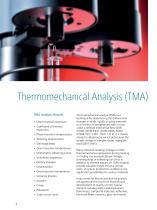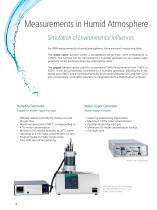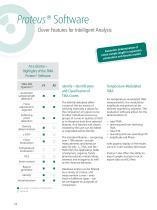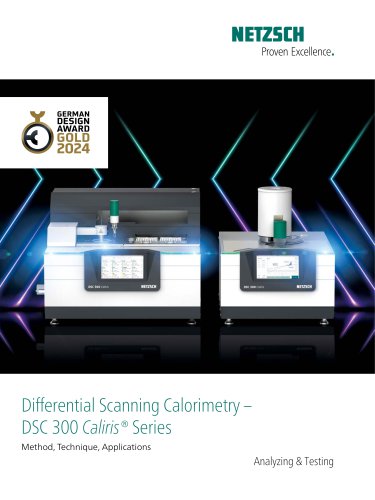 Website:
NETZSCH Analyzing & Testing
Website:
NETZSCH Analyzing & Testing
Group: NETZSCH
Catalog excerpts

TMA 402 F1/F3 Hyperion® Thermomechanical Analysis – TMA Method, Technique and Applications Analyzing & Testing
Open the catalog to page 1
Thermomechanical Analysis (TMA) TMA Analysis Results ■ Linear thermal expansion ■ Coefficient of thermal expansion ■ Phase transition temperatures ■ Sintering temperatures ■ Shrinkage steps Glass transition temperatures Dilatometric softening points Volumetric expansion Density changes Delamination Decomposition temperature Sintering kinetics Isostrain Creep Relaxation Stress/strain curve Thermomechanical analysis (TMA) is a technique for determining the dimensional changes in solids, liquids or pasty materials as a function of temperature and/or time under a defined mechanical force (DIN...
Open the catalog to page 2
Thermal Expansion The linear thermal expansion is an important variable for assessing the dimensional behavior of a material in response to a change in temperature. Measurement on an epoxy resin with a sample length of 6 mm in expansion mode (fused silica sample holder); 1st and 2nd heating runs at a rate of 2 K/min This plot shows the thermal expansion (dL/L0 in %) of an epoxy resin between -70°C and 270°C. In the first heating (blue curve), the onset of the glass transition (Tg) occurs at 123°C. In the second heating (red curve), the onset of Tg is slightly shifted, to 125°C. This shift...
Open the catalog to page 3
Detects Even the Slightest Dimensional Changes The LVDT constitutes the centerpiece of the NETZSCH TMA 402 F1/F3 Hyperion®. The technology behind it is tried-and-true: Even the slightest of length changes, into the nanometer range (digital resolution of 0.125 nm), can be measured and detected. A variation of furnace options for all applications To adjust the instrument for various temperature ranges and varied atmospheres, all that needs to be done is to change the furnace. This can be carried out by the operator. Thanks to the double furnace hoist, switching to a second furnace only takes...
Open the catalog to page 4
The force operating on the sample is generated electromagnetically. This ensures a quick response time for experiments with a changing load. A highly sensitive force sensor (digital resolution < 0.01 mN, max. force ±4 N) continuously measures the force exerted via the pushrod and readjusts it automatically. This sets the NETZSCH TMA 402 F1/F3 Hyperion® apart from other instruments which only use preset values. Displacement control From Sensitive to Stiff Materials The electronic control system allows users to set the force value in the mN-range. This enables testing even on sensitive...
Open the catalog to page 5
Highest Flexibility at Maximum Precision The modular design of the TMA 402 F1/F3 Hyperion® makes it unique among the competition. You are always prepared for the future! One Instrument – Different Temperature Ranges -150°C to 1000°C Steel furnace with LN cooling IC-furnace with mechanical cooling without the need of LN21 SiC furnace Copper furnace, allows for measurements under controlled humidity environment from 0°C to 100°C Water-vapour furnace connected to a water-vapour generator LN2 liquid nitrogen cooling g volvin ases e nt? he g tme ed in t terest thermal trea o In an als during...
Open the catalog to page 6
Measuring Modes and Sample Holders Sample Holders for Copper, Steel, Water Vapor and SiC Furnce Sample holders made of fused silica for the range from -150°C to 1100°C Expansion/ compression – pushrod with flat tip, Ø 4 mm Penetration – pushrod with flat tip, Ø 1 mm Tension, max. tension length 30 mm Sample holders made of alumina for the range from RT to 1550°C 3-point bending for free bending lengths 10 mm and 20 mm Sample Holders Made of Fused Silica for IC Furnace* *can be combined with other TMA furnaces Expansion/ Penetration Tension, 3-point bending, max. tension for free bending...
Open the catalog to page 7
Measurements in Humid Atmosphere Simulation of Environmental Influences For TMA measurements in humid atmospheres, there are two furnaces available. The water-vapor furnace covers a temperature range from room temperature to 1250°C. The furnace can be connected to a humidity generator or to a water-vapor generator which produces steam by evaporating water. The copper furnace can be used for conventional TMA measurements from -150°C to 500°C. It can be conveniently connected to a humidity generator, allowing for in-situ drying up to 500°C and a controlled humidity environment between 0°C and...
Open the catalog to page 8
Swelling Behavior of Wood Under Humid Conditions In the hygroscopic wood moisture range, the dimensions and the volume undergo change when moisture is absorbed by swelling and when moisture is released by shrinkage. For the practical use of wood, the following are particularly important: The dimensions of dry wood in the three anatomical directions when the ambient climate changes (differential swelling, swelling coefficient). The shrinkage of wood when drying from the wet (fresh) to the normal condition (drying rate). To test the swelling behavior on beech wood, three samples were cut from...
Open the catalog to page 9
At a Glance -Highlights of the TMA Proteus® Software F1 TMA 402 Hyperion® Automatic sample length detection Force adjustment/ segment Softening point detection Density determination c-DTA® Force modulation Temperature modulation RCS Strain control Report generator Identify AutoEvaluation ■Included in standard configuration □ Optional Identify - Identification and Classification of TMA Curves The Identify database offers a state-of-the-art means of verifying materials; it allows for the comparison of a given curve to other individual curves (e.g., groups of curves in quality control) or to...
Open the catalog to page 10
AutoEvaluation AutoEvaluation is an intelligent software functionality exclusively offered by NETZSCH. It is a selfacting evaluatin of thermoana-lytical measurement curves that works without using pre-defined macros. This is an immense support and time saver. AutoEvaluation offers special functions for the evaluation of various materials. When testing Metals, "Metal Melting" will automatically evaluate the onset of melting. "Glass Transition and Softening" displays the onset of glass transition and the peak of softening with just one click. Measuring ceramics, sintering steps will be...
Open the catalog to page 11All NETZSCH Analyzing & Testing catalogs and technical brochures
-
TG 309 Libra Series
24 Pages
-
STA 449 F5 Jupiter®
16 Pages
-
DMA 303 Eplexor
24 Pages
-
ARC® 244 ARC® 254
1 Pages
-
HMOR 422
1 Pages
-
RUL/CIC 421
1 Pages
-
Product Overview
12 Pages
-
Kinexus Prime DSR Series
20 Pages
-
DIL 402 Expedis Select/Supreme
28 Pages
-
Rosand Series
20 Pages
-
Kinexus Prime Series
20 Pages
-
Advanced Materials Testing
32 Pages
-
NTA Fire Testing Systems
20 Pages
-
NTA Guarded Hot Plate Series
16 Pages
-
Cone Calorimeter TCC 918
12 Pages
-
Photo-DSC 204 F1 Phoenix®
8 Pages
-
NTA HotBoxes Test Chambers
16 Pages
-
Thermal Insulation Materials
24 Pages
-
TA-QMS Coupling
16 Pages
-
STA 2500 Regulus
12 Pages
-
SBA 458 Nemesis®
24 Pages
-
NTA HotBoxes
16 Pages
-
NETZSCH NEVIO Instrument Series
24 Pages
-
LFA 467 HyperFlash® Series
28 Pages
-
LFA 427 - product brochure
24 Pages
-
Kinetics NEO
16 Pages
-
TG-FTIR - product brochure
24 Pages
-
DMA GABO EPLEXOR up to 1500°C
12 Pages
-
DMA GABO DiPLEXOR
8 Pages
-
DIL 402 Expedis Classic
16 Pages
-
DEA 288 Ionic
20 Pages
-
Accelerating Rate Calorimetry
20 Pages
-
GABO DiPLEXOR®
8 Pages
-
GABOMETER®
8 Pages









































































